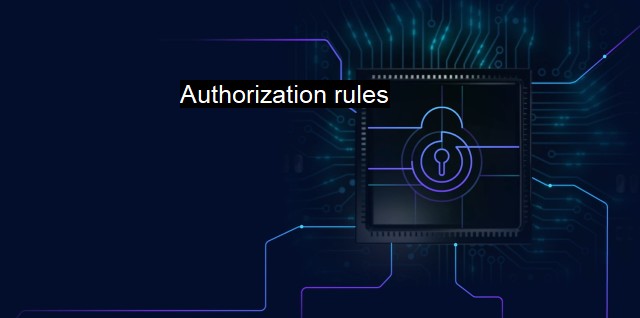What are Authorization rules?
Securing Access: The Importance of Authorization Rules in Cybersecurity and Antivirus Software
Authorization rules are established directives that define the permissions or privileges commanded by users when they access a system in a computing environment, specific to the cybersecurity and antivirus domain. these rules ensure that IT systems are accessible to only those who have the authority to perform certain operations. Typically, this involves limiting a user's actions within a system, clarifying what tasks can be conducted, who can perform those tasks, and under what conditions those tasks can be carried out. These practices contribute significantly to the implementation of access controls, thereby securing confidential information and minimizing cyber threats.Authorization rules leverage the principle of least privilege (PoLP), an information security concept implying that a user must be granted the minimum levels of access, or permissions, necessary to complete his or her job functions. When authorization rules are strictly enforced, users cannot access information that does not pertain to their roles, not unduly elevating their access privileges. Consequently, this lowers the chances of accidental or intentional misuse of sensitive information.
Within the cybersecurity domain, these rules perform a pivotal role, especially while handling permissions for applications, files, and folders, both in cloud and on-premises environments. They are considered standard parameters defined in access control lists (ACLs), terms and conditions in cybersecurity policies, and preconditions segmenting user process representations. They serve to filter actions, component utilization, or data reporting based on the user's privileges. they help systematize preventive actions against security breaches and supervise risk controls in antivirus programs.
Authorization rules are critical to antivirus software because they help establish a secure procedure between what the software can access and what it cannot. These rules should ideally balance sufficient system access for the software to detect and neutralize potential threats while preventing the antivirus itself from becoming a cause of vulnerability. By defining authorization rules, antiviruses gain the ability to scan certain files and directories or to quarantine, delete or otherwise manipulate items deemed threatening.
These rules can induce break-worthy policies, turning the tides of cyber threats, like providing users the ability to view data but preventing data modification or deletion. This segregation of duties is another cornerstone for guaranteeing cybersecurity and preserving integrity in data management, demonstrating how authorization rules lay the groundwork for contextual boundary creation, which strengthens the posture of cybersecurity defenses.
It's crucial not to overlook the potential risks associated with incorrectly configured authorization rules. Misconfigurations or sub-optimal rules can inadvertently leave systems open to external hacking attempts or internal misuse, disrupting data confidentiality, integrity, and availability - the three main pillars of cybersecurity. Therefore, regular and systematic audits of these rules, corresponding practices, and updating them in the light of changing risk landscapes and business requirements is necessary.
Authorization rules form a bulwark of cybersecurity and antivirus strategies, serving as the key differentiator between secure access and potential breaches. They are integral to facilitating tailored permissions among users, preventing unauthorized actions, and preserving a structured and robust barrier against cyber threats. Reviewing these rules might seem like a daunting task for many organizations; the cost of ineffective or outdated access guidelines could involve a compromising security incident, which, undoubtedly makes their constant upkeep pivotal in maintaining safe and secure interactions with the cyber world.

Authorization rules FAQs
What are authorization rules in cybersecurity?
Authorization rules are a set of guidelines that determine who has access to specific resources in a system. They are a vital component of cybersecurity and antivirus software to prevent unauthorized access, data breaches, and other security-related issues.How do authorization rules work in antivirus software?
In antivirus software, authorization rules determine which applications can access specific device resources, such as the camera, microphone, or file system. They can also restrict network access to only approved programs, preventing malware from communicating with other devices.What is the importance of authorization rules in cybersecurity?
Authorization rules are essential in cybersecurity as they ensure that only authorized personnel or programs have access to sensitive data, applications, or devices. They prevent unauthorized access, data breaches, and other types of cyber attacks, thereby enhancing overall system security.How can I set up authorization rules in my antivirus software?
To set up authorization rules in your antivirus software, you need to identify the resources you want to protect and configure access restrictions for each resource. Most antivirus software comes with preconfigured authorization rules, but you can also customize them according to your specific needs. It's crucial to keep your authorization rules up to date and review them regularly to ensure optimal cybersecurity.| | A | | | B | | | C | | | D | | | E | | | F | | | G | | | H | | | I | | | J | | | K | | | L | | | M | |
| | N | | | O | | | P | | | Q | | | R | | | S | | | T | | | U | | | V | | | W | | | X | | | Y | | | Z | |
| | 1 | | | 2 | | | 3 | | | 4 | | | 7 | | | 8 | | |||||||